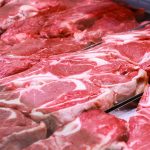 The essential difference between the words meat and flesh is that we eat the former and are the latter; in other words, although the two words denote more or less the same thing, we prefer to think of the pork chop on our plate as meat, not flesh, and we prefer to think of ourselves as flesh and blood, not meat and blood. However, the two words have shifted and shared meanings many times over the centuries. The word flesh, first recorded in the ninth century, originally referred specifically to the part of an animal eaten as food; it was not until the eleventh century that its meaning widened and it came to signify animal tissue in general, whether prepared for the table or left on the animal. On the other hand, meat, which is first recorded in the tenth century, originally referred to a portion of food of any kind, whether it was made from animals or vegetables or fish or fowl; a thousand years ago, therefore, the only things you swallowed were meat and drink. It was not for another four hundred years, in the fourteenth century, that meat narrowed its meaning and came to signify, as it still does, flesh used for culinary purposes. Etymologically, the two words are unrelated. Flesh developed from an Indo-European word, pronounced something like pel, that meant split, the slaughtering of an animal for its flesh necessitating that you split it open. The word flitch, meaning a side of bacon, derives from the same Indo-European source as flesh. The word meat, on the other hand, developed from another Indo-European word, pronounced something like mat, that meant measure, the connection being that meat originally signified a portion—or measure—of food. This Indo-European word is also the source of meat’s many relatives, including menstruation and moon (both of which undergo measurable cycles), month (a unit of time measured by the cycle of the moon), and meal (food eaten at a measured or set time). The word meat is also closely related to the word mate, meaning friend: mate derives from the Old English word gemetta, meaning together with meat—in other words, a mate is someone with whom you share meat.
The essential difference between the words meat and flesh is that we eat the former and are the latter; in other words, although the two words denote more or less the same thing, we prefer to think of the pork chop on our plate as meat, not flesh, and we prefer to think of ourselves as flesh and blood, not meat and blood. However, the two words have shifted and shared meanings many times over the centuries. The word flesh, first recorded in the ninth century, originally referred specifically to the part of an animal eaten as food; it was not until the eleventh century that its meaning widened and it came to signify animal tissue in general, whether prepared for the table or left on the animal. On the other hand, meat, which is first recorded in the tenth century, originally referred to a portion of food of any kind, whether it was made from animals or vegetables or fish or fowl; a thousand years ago, therefore, the only things you swallowed were meat and drink. It was not for another four hundred years, in the fourteenth century, that meat narrowed its meaning and came to signify, as it still does, flesh used for culinary purposes. Etymologically, the two words are unrelated. Flesh developed from an Indo-European word, pronounced something like pel, that meant split, the slaughtering of an animal for its flesh necessitating that you split it open. The word flitch, meaning a side of bacon, derives from the same Indo-European source as flesh. The word meat, on the other hand, developed from another Indo-European word, pronounced something like mat, that meant measure, the connection being that meat originally signified a portion—or measure—of food. This Indo-European word is also the source of meat’s many relatives, including menstruation and moon (both of which undergo measurable cycles), month (a unit of time measured by the cycle of the moon), and meal (food eaten at a measured or set time). The word meat is also closely related to the word mate, meaning friend: mate derives from the Old English word gemetta, meaning together with meat—in other words, a mate is someone with whom you share meat.
The flesh of animals, including that of cows, pigs, poultry, and others. Meat is a concentrated source of proteins, fats, cholesterol, calories, and many vitamins and micronutrients. It contains significant amounts of B complex vitamins (thiamine, riboflavin, niacin), iron, and other minerals. It has limited amounts of calcium and fiber. Its metabolic byproducts include organic acids.
Culinary indulgence knows no bounds when it comes to the consumption of the succulent flesh derived from various creatures. Examples include the delectable pig, whose meat is referred to as pork, the tender flesh of a calf known as veal, the savory steer transformed into beef, the delectable sheep offering mutton and lamb, the majestic deer providing venison, and the agile rabbit offering its flavorful meat. However, it is worth noting that a plethora of other animal species contribute to the diverse culinary traditions observed across different corners of the globe, each region embracing its own unique array of edible fauna.
